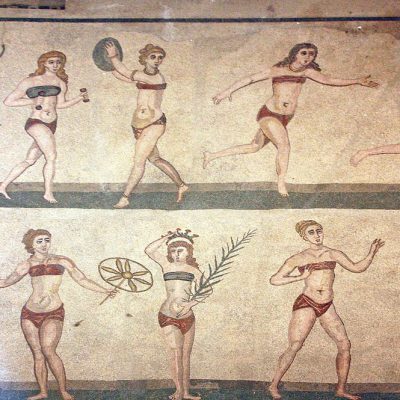Chapters
Ovid, a Roman poet of the Augustus epoch, in his work Medicamina Faciei Feminae, which is a short work on a care of the female body, indicates what is female beauty: pale complexion, rosy cheeks, dark eyes devoid of unnatural odours of skin.
In fact, the Romans were not the first to pay attention to feminine beauty. Already the Egyptians and Greeks created their own canons of beauty, which later influenced the imagination of the Romans. The work of Ovid, Medicamina Faciei Feminae in a neat way shows the subsequent changes that occurred in Roman society in the way of perceiving female beauty, from the founding of the Eternal City to the time of the author (1st century BCE – 1st CE). Romans, unlike the Egyptians or Greeks, used makeup only to emphasize natural beauty, and not create a whole range of colours on the face.
Ovid outside of the exterior also indicates that the woman should take care of her character traits, which, if properly cared for, will provide her with stable marital life and husbands’ love.
During the life of Ovid, the ideal of beauty boiled down to the woman’s pale skin. If this one was unburnt, it pointed out that the Roman had spent most of her time at home, and that she was rich enough to have her slaves. Women often whitened their skin with chalk, and their lips and cheeks colored with red clay. Ovid gives a recipe for the whitening mixture:
Take two pounds of peeled barley and an equal quantity of vetches moistened with ten eggs. Dry the mixture in the air, and let the whole be ground beneath the mill-stone worked by the patient ass. Pound the first horns that drop from the head of a lusty stag. Of this take one-sixth of a pound. Crush and pound the whole to a fine powder, and pass through a deep sieve. Add twelve narcissus bulbs which have been skinned, and pound the whole together vigorously in a marble mortar. There should also be added two ounces of gum and Tuscan spelt, and nine times as much honey. Any woman who smears her face with this cosmetic will make it brighter than her mirror.
– Ovid, Medicamina Faciei Feminae
Extravagant baths in donkey’s milk adhered to beautiful skin (for Cleopatra VII); swan fat and flour from legumes were to help in the elimination of wrinkles; in turn, the incinerated snails were to help remove the freckles – in the Romans’ feeling a negative sign of women staying in the sun for too long. All spots on the body and unattractive pimples were hidden with the help of pink color, chalk, poppy petals or crocodile droppings.
The Roman women accented the eyes with the help of kohl, also called the cauldron, which was made and is to this day from ash and soot. This dye appeared in Rome thanks to the Egyptians and is used in the Middle East and Turkey to this day. Like modern women, the dye was spread under and over the eyes to give them a natural look. The same product was used to darken eyelashes and eyebrows. Different colours were applied to the eyelids from green to malachite or from blue to azurite. Roman women preferred long eyelashes and eyebrows.
Cosmetics were used by both rich and poor women. Naturally, however, richer Romans could afford a wider range of products and substances. The better potions did not smell; worse, the woman required the use of perfumes to camouflage an uninteresting scent. That is why the Roman brothel was characterized by a mixture of stench made of make-up materials (used by prostitutes) and strong perfumes. In addition, the older the woman was, the more she tried to hide her wrinkles. For this purpose, she used more makeup and the client knew that he was dealing with an elderly prostitute.
What is worth emphasizing, all antique sources that survive our times and treat women’s beauty have been written by a masculine hand. Ovid preferred strong when other authors appreciated the light or lack of make-up. There is no doubt, however, that the Romans paid a lot of attention to their beauty, just as modern women do. Naturally, the canons of beauty were different.
Body structure
Which silhouettes were considered beautiful in ancient Rome? We can assess on the basis of preserved sculptures, paintings, and mosaics. The beautiful woman was short and slim, but with a strong physique, narrow shoulders, pronounced hips, wide thighs and small breasts. The face, in turn, should have large eyes, a sharp nose, medium lips and ears, oval cheeks and a chin.










